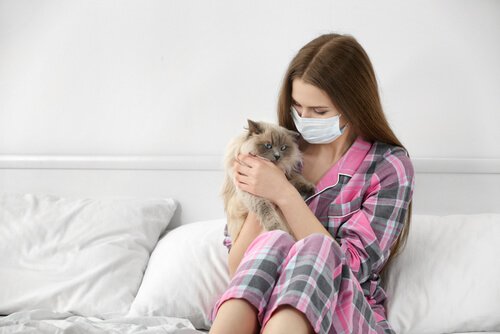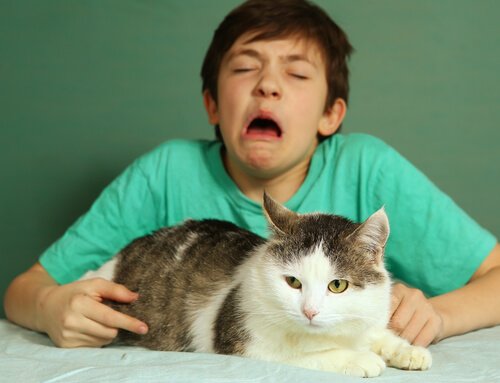Cat Allergy: How to Treat It

Many people believe that cat allergies are caused by a cat’s hair, but that’s not true. Dandruff in the cat’s skin is what really causes them and unfortunately, many people have cat allergies. In this article, we’ll give you some advice on how to treat the symptoms.
What Causes Cat Allergies?
It’s common to hear people say that they’re allergic to cat hair but in actuality the hair doesn’t cause the sneezing, red eyes, coughing, or skin rashes. To understand what actually causes this reaction, you need to become familiar with the Fel d 1 protein that’s in felines. Although it’s very small, it can be quite dangerous.
Cat allergies are caused by the spreading of dandruff that carries this molecule. Dandruff spreads throughout the house due to the constant licking and grooming of cats. In doing so, they shed a lot of dry skin, along with this protein.
Some people’s immune system is more sensitive to pollen or mites. Also, someone with asthma is much more likely to develop a cat allergy due to their immune system not being able to cope with the microorganisms flying around in the air.

Although how bad it might affect someone all depends on their immune system, there are other factors that can make the symptoms even worse. For example, male cats produce more allergen secretions when compared to females. This can be reduced if the cat is sterilized.
Advice for Treating Cat Allergies
Having cat allergies is no reason to put your pet up for adoption. On the contrary, pay attention to the following advice in order to make the environment more livable for you and your cat.
1. Have a “Cat-free” Room
This could be your bedroom or your children’s bedroom. Your cat should not be allowed to have access to this room, especially if it’s carpeted. Therefore, you can spend some parts of your day in a space that free from allergens.
Obviously, there is no way to stop allergens from flying all over the house, but you have a space that doesn’t have that many flying in the air.
2. Say Goodbye to Fabric
As mentioned earlier, carpets are a great place for dandruff and dead skin cells. Also, sofas, curtains, and cushions are good places too, so try to reduce the amount of fabric in your house, either by removing all fabric product, changing your furniture, among other things.
Pick out easy to clean materials or even cover certain pieces of furniture with plastic. If you’ve got fabrics that don’t repel dust, then you should clean them on a regular basis to get rid of dandruff and control your cat allergies.
3. Get an Air Purifier
They’re easy to get hold of and used often in houses where people have allergies. They stop the air from becoming dry. The purifier should contain a HEPA filter, which will effectively filter particles from the air.

4. Vacuum on a Regular Basis
Cleaning is really important for preventing a build-up of hairs and microorganisms. Therefore it’s a good idea to vacuum the house at least ones a week, including your “cat-free” area.
Since sweeping can lift up dust particles and cause symptoms to appear, a vacuum cleaner can be really useful. Depending on the model, some come with special attachments to vacuum curtains, furniture, etc.
5. Brush Your Cat
It’s important to remove your cat’s excess fur and dead cells. Although your cat will take care of its own grooming, this isn’t enough to stop the spread of dandruff and allergens.
Have brushing become part of your cat’s routine and get him used to it, so he takes it as something enjoyable. Otherwise, he might try to bite or scratch you, or even run and hide.
Finally, don’t forget to clean your cat’s bed and any other objects he uses because they can be filled with allergens as well.
This text is provided for informational purposes only and does not replace consultation with a professional. If in doubt, consult your specialist.







